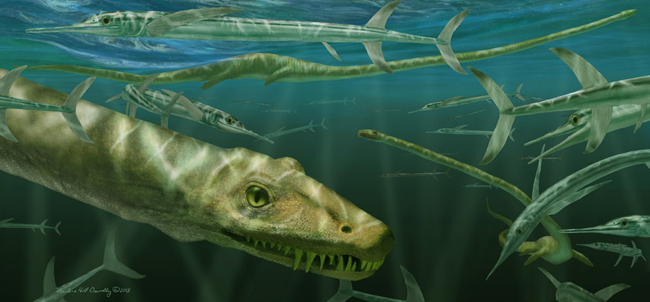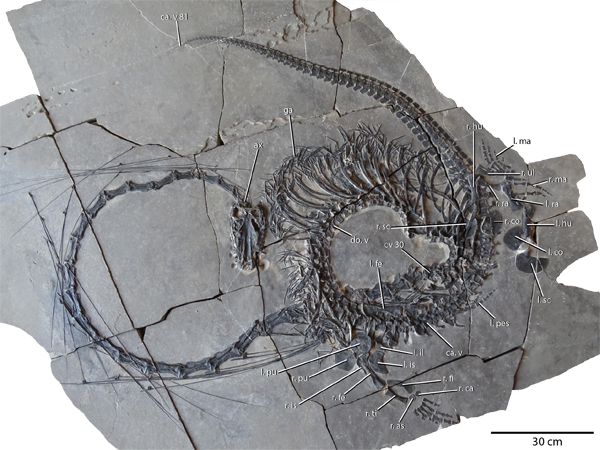A team of scientists have described new specimens of Dinocephalosaurus orientalis a bizarre, Triassic marine reptile. First scientifically described in 2003 (Li Chun), this new study has permitted scientists to construct the enormous neck of this animal in detail.
Measuring up to five metres in length, Dinocephalosaurus orientalis had an extremely long and flexible neck. The neck contains a total of thirty-two vertebrae. Tanystropheus in contrast, had thirteen cervical vertebrae. In some specimens the neck is 1.7 metres in length. It is much longer than the animal’s torso. The researchers compare D. orientalis to the Tanystropheus taxon. Tanystropheus is known from the Middle Triassic of Europe and China. Whilst Tanystropheus and Dinocephalosaurus had similar body shapes, these reptiles were not closely related. The long necks seen in these two taxa are an example of convergent evolution.

Dinocephalosaurus orientalis A Remarkable Marine Reptile
The scientific paper describing the animal is published in full in the academic journal Earth and Environmental Science: Transactions of the Royal Society of Edinburgh – forming the entirety of the latest volume.
Fellow of the Royal Society of Edinburgh and Editor-in-Chief of the RSE’s academic journal Transactions, Professor Robert Ellam FRSE commented:
“This remarkable marine reptile is another example of the stunning fossils that continue to be discovered in China”.
Comparisons with Tanystropheus
Both reptiles were of similar size and have several features of the skull in common, including a fish-trap type of dentition. However, Dinocephalosaurus is unique in possessing several more vertebrae both in the neck and in the torso, giving the animal a much more snake-like appearance. The neck of Dinocephalosaurus was more flexible than the neck of Tanystropheus. The fossils analysed in the newly published paper come from the Guizhou Province of China.

Dr Nick Fraser FRSE, Keeper of Natural Sciences at National Museums Scotland stated:
“This discovery allows us to see this remarkable long-necked animal in full for the very first time. It is yet one more example of the weird and wonderful world of the Triassic that continues to baffle palaeontologists. We are certain that it will capture imaginations across the globe due to its striking appearance, reminiscent of the long and snake-like, mythical Chinese Dragon.”
Appropriate for the “Year of the Dragon”
As we have now entered the Chinese “Year of the Dragon”, a new scientific paper on a Chinese reptile that superficially resembled a mythical dragon is highly appropriate. The fossils were studied over a period of ten years by researchers from Scotland, China, America and Germany.
Professor Li Chun from the Institute of Vertebrate Palaeontology and Palaeoanthropology in China, the scientist who originally described Dinocephalosaurus orientalis said:
“This has been an international effort. Working together with colleagues from the United States of America, the United Kingdom and Europe, we used newly discovered specimens housed at the Chinese Academy of Sciences to build on our existing knowledge of this animal. Among all of the extraordinary finds we have made in the Triassic of Guizhou Province, Dinocephalosaurus probably stands out as the most remarkable.”
Scientists propose that Dinocephalosaurus was superbly adapted to its marine environment. Given the length of its neck, moving on land would have been difficult. A remarkable fossil described in 2017 revealed that Dinocephalosaurus was viviparous (live birth). This remains the only record of viviparity associated with the Archosauromorpha.
To read Everything Dinosaur’s blog post about this discovery: First Evidence of Live Birth in Ancient Dinosaur Relative.
Dinocephalosaurus orientalis – Significant Fossil Discoveries
Dr Stephan Spiekman, a postdoctoral researcher based at the Stuttgart State Museum of Natural History, commented:
“As an early-career researcher, it has been an incredible experience to contribute to these significant findings. We hope that our future research will help us understand more about the evolution of this group of animals, and particularly how the elongate neck functioned.”
The paper describing the animal is published in full in the academic journal Earth and Environmental Science: Transactions of the Royal Society of Edinburgh – forming the entirety of the latest volume. The journal was first published in 1788.
Everything Dinosaur acknowledges the assistance of media releases from the Royal Society of Edinburgh and National Museums Scotland in the compilation of this article.
Visit the Everything Dinosaur website: Everything Dinosaur.






Good luck 🙂